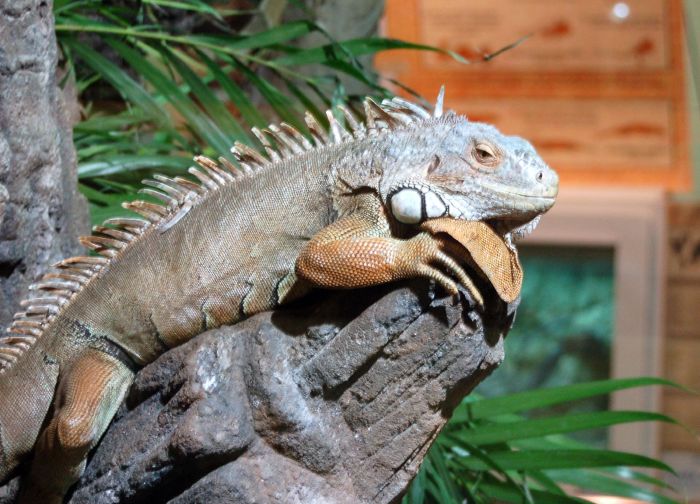Buying a pet iguana is beneficial only when buying directly from the pet shop. If you are buying it from online pet shop or from another person, request to inspect the iguana in person & follow this detailed guide to buying a pet iguana;
Before proceeding, please make sure that you’re familiar with things to know before buying an iguana and make sure that this is the right pet for you.
Also, if possible, consider adopting an iguana rather than buying it from the pet store. As often stated, iguanas are one of the most misunderstood pets – new owners often rush into acquiring one without any knowledge what responsibility they are going into. Almost 70% of iguanas bought in pet stores end abandoned, or dead, during the first year after reaching new owner’s home. Luckier ones get their shelter in animals rescue centers but it’s not a long-time solution.
You’re still in? Great, the next step is reaching the pet store where you can see iguana and check its condition.
The first one is a physical test. Make sure the pet-shop allows you to hold the iguanas you choose. When you physically check the iguana, you can look out for any sign of illness or existing wound that might appear on the iguana.
The skin should appear firm, clear, clean, and free from bites and scratches (Bites and scratches mean they might be infected).
The abdomen should be free of burns, burns may eventually heal, but the skin will always be very sensitive to heat, usually, many hobbyists use hot electric stones to warm the iguana which can be harmful to the iguana. Check for this signs as well.
Below the stomach, there should be no dirt (dirty stomach indicates that the animal lives in an unhygienic environment that can make it sick and weak.)
Their genitals should be free of dried dirt and urine. (This suggests that the lizard may have parasites and protozoa in the stomach.)
The iguanas balk when the parts of their body are moving (weakness and instability may be a sign that the lizard is injured or suffering from calcium deficiency.) Limbs, tail, and whole body should have no lumps or swelling (Cysts, infections, and fractures in animals require treatment.)
The hind legs and thighs should be normal (Swollen legs may show a fracture, if two legs or thighs are weak, indicating a lack of calcium supply.)
The limbs must be sturdy and fat, while the body is also smooth and vibrant. If the hands and feet are very thin, might be a sign of a lizard being starved or dehydrated. If the body looks wrinkled and dry, there may be a bacterial or parasitic (like, mites) infection.
The eyes should be clear (If the eyes are blurry, crusty, or watery, there may be an infection of the respiratory system or inflammation of the eye.)
The nose should not be dry or filled with wet mucus (Dry mucus or foam is an indication of infection in the respiratory system.) Look inside the mouth. (Infections will cause serious illness.)
The jaw should not be swollen (if it is swollen, then the animal may have a metabolic disease). No swelling or bumps on his face, wetting, or neck (Magnification may indicate an abscess.)
Review:
When purchasing an iguana from a pet store, it’s crucial to pay attention to several factors to ensure you’re getting a healthy and well-cared-for reptile. Here are some key points to consider:
- Appearance:
- Look for clear eyes, alertness, and a well-groomed appearance.
- Check for signs of shedding or retained shed skin, which can indicate overall health.
- Behavior:
- Observe the iguana’s behavior; it should be alert, active, and responsive.
- Avoid iguanas that show signs of aggression, lethargy, or excessive hiding.
- Appetite:
- Check if the iguana is eating regularly and has a healthy appetite.
- Inquire about the type of diet the iguana has been receiving in the pet store.
- Cleanliness:
- Assess the cleanliness of the enclosure; it should be well-maintained and free of feces or uneaten food.
- Size and Age:
- Consider the size of the iguana; younger iguanas are often easier to handle and adapt better to captivity.
- Ask about the iguana’s age and growth history.
- Tail and Limbs:
- Examine the tail for any signs of injuries or retained shed.
- Check the limbs for signs of swelling or deformities.
- Skin and Scales:
- Look for smooth and intact scales without discoloration or lesions.
- Check for signs of mites or other parasites.
- Nose and Mouth:
- Ensure the iguana’s nostrils are clear and free of discharge.
- Check for any abnormalities in the mouth, such as swelling or discharge.
- Quarantine:
- Consider quarantining the new iguana for a period to prevent the potential spread of diseases to other reptiles you may own.
- Ask Questions:
- Inquire about the iguana’s origin, diet, and any medical history or health concerns.
- Request information on the enclosure setup and any specific care requirements.
Remember, it’s important to do thorough research on iguana care and consult with a veterinarian to ensure you can meet the specific needs of this reptile species before bringing one home.


